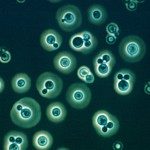Link to Pubmed [PMID] – 19218187
J. Biochem. 2009 Apr;145(4):413-9
The yeast Candida albicans is an opportunistic pathogen that causes infections in immunocompromised individuals with a high morbidity and mortality levels. Recognition of yeasts by host cells is directly mediated by cell wall components of the yeast, including a wide range of abundantly expressed glycoconjugates. Of particular interest in C. albicans are the beta-mannosylated epitopes that show a complex expression pattern on N-glycan moiety of phosphopeptidomannans and are absent in the non-pathogenic species Saccharomyces cerevisiae. Being known as potent antigens for the adaptive immune response and elicitors of specific infection-protective antibodies, the exact delineation of beta-mannosides regulation and expression pathways has lately become a major milestone toward the comprehension of host-pathogen interplay. Using the newly developed HR-MAS NMR methodology, we demonstrate the possibility of assessing the general profiles of cell-surface-exposed glycoconjugates from intact living yeast cells without any prior purification step. This technique permitted to directly observe structural modifications of surface expressed phosphodiester-linked beta-mannosides on a series of deletion strains in beta-mannosyltransferases and phospho-mannosyltransferases compared with their parental strains.


